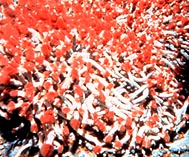Tubeworms 1


The red at the top of the tubeworm is due to hemogloblin. One of the other unique aspects of the tubeworm environment is the extremely large amount of sulfides. Sulfides present two problems to tubeworms. First, free sulfide reacts with oxygen. Second, they have to provide sulfides to the symbiotic bacteria that provide the tubeworms nutrients.
Tubeworm 2


Tubeworms actually have two different types of hemoglobin. The second type is more interesting. "The hollow spherical structure in the hemoglobin of this species includes 12 zinc ions in depressions at the outer part of the molecule," explains Flores. "These ions form a reversible bond with the hydrogen sulfide molecules that could block the oxygen-carrying sites, allowing the molecule to simultaneously carry oxygen and sulfide."
Flores says that the hollow spherical structure is unique. "Human and other hemoglobins have a 'globular' form, but none have been discovered with this symmetrical sphere. This sphere is a very stable shape, which may be part of the adaptation for the extreme conditions in which these worms thrive."


Recent medical studies have focused on the worm's large hexagonal hemoglobins as possible substitutes for oxygen carriers in human blood. "The newly characterized molecule is substantially smaller than the hexagonal hemoglobin, reducing problems of removal by kidney filtration, but still has six times as many active oxygen-carrying sites as human hemoglobin," Flores adds..
So, by studying the evolution of tubeworm:
"Our discovery, which results from a very multi-disciplinary approach, replaces the current paradigm for the evolution of worm hemoglobin by demonstrating that hydrogen-sulfide molecules are bound by a metal ion rather than by an arrangement of amino acids."
we are led to a possible substitute for oxygen carriers in human blood - which could have many medical applications! Who says evolutionary theory doesn't have implications for medical research?
For more info go to:
Science Daily , PBS , Exploring the Deep Frontier , Dr C's Remarkable Ocean World and Here for more info.








